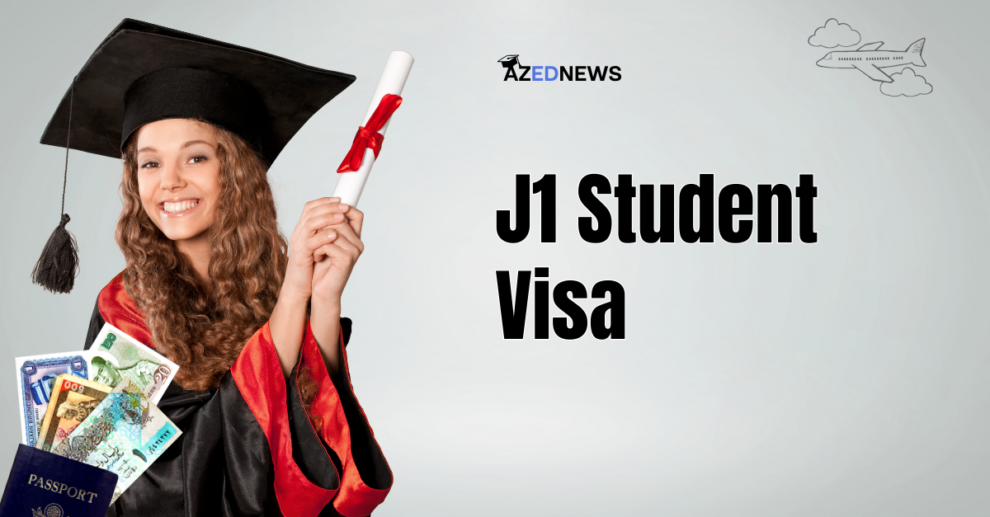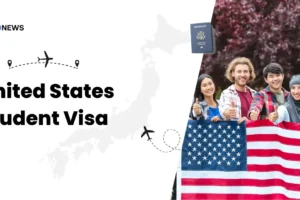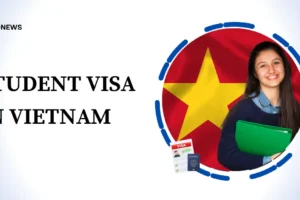Are you a student planning to study in the USA? If yes, then you are at the right place. Before applying for a J1 student visa, it is important to know the total cost involved for studying in the USA.
Table of Contents
When thinking about the cost of studying in the U.S, you should consider various factors. You need to consider expenses like your tuition fees, accommodation, health insurance etc. Once you know these costs, you can easily apply for your J1 student visa.
In this article, we will discuss the eligibility criteria, application process, interview tips, and more for the J1 student visa in the United States. Keep reading this article to know more about it.
What is the J1 student visa?
If you are from outside the US and want to join study or work exchange programs, you can apply for the J1 visa. It is also known as the Exchange Visitor Visa or J student visa. It is approved by the Department of State Bureau of Educational and Cultural Affairs. Usually, a J1 visa holder is sponsored by an educational or nonprofit organization. There are 15 categories for this visa. It includes roles like Au Pair, Camp Counselor, College and University Student, and more. We will discuss these roles in detail further in the article.
If you are applying for a J1 student visa in the College and University Student Program category, you can study at a US college or university for the duration of your course. Your stay length in the US depends on the program you choose. For example, if it is for a Camp Counselor program, it might be short (like four months over the summer), but for programs like Au Pair or Research Scholar, it could be several years.
After you finish your studies, you are required to go back to your home country and live there for at least two years. You can only come back to the US after meeting this requirement unless there are special circumstances or emergencies.
Types for J1 Student Visa
Here are the 14 different categories of J1 student visas. Let’s have a look at them.
1. Au Pair
If you are interested in being an au pair in the US, it means you will take care of a family’s children in exchange for a place to stay, food, and some money. You must meet the following criteria:
- You need to be between 18 and 26 years old
- You should be healthy
- You must have some experience with childcare
- You should know English
- You must have finished high school
- You also should not smoke if the family doesn’t want you to
- You will need a police clearance report
- You must have an international driver’s license with at least 50 hours of driving experience.
- You must be okay with living away from home for a year
- You should never have been an au pair in the US before.
Before you start, you might have to interview in your home country with the organization sponsoring you, and you might have to talk with a few families over the phone. They also have to give you at least 32 hours of training in childcare.
While you are working, you can’t take care of the kids for more than 10 hours a day or 45 hours a week. You also have to study for at least six hours at a US college or university. Your job includes taking the kids to school and activities, helping with homework, keeping their rooms clean, and cooking for them.
The family you are staying with should pay up to $500 for your college classes and give you your room and meals. They should also pay you for the work you do as per the Fair Labor Standards Act.
2. Camp Counselor
If you are interested in being a camp counselor in the US, you must be good with kids and know English. You must be at least 18 years old. You should also be a college student, a youth worker, a teacher, or have special skills.
When you work as a camp counselor, the camp will provide you with food and a place to stay for free. You will get paid like American counselors and have similar benefits. You will mainly work with kids, but sometimes you might have to do other tasks. You can be a counselor for up to four months, and you cannot stay longer.
3. College and University Student Program
This program lets you study at American colleges or universities as a foreign student. You need to be enrolled in a full-time course and maintain good grades. Sometimes, you might also do an internship related to your degree back home.
To join this program, your funding must come from sources other than yourself or your family. It could be from the US government, your home country’s government, or an international organization the US is part of.
This program follows an agreement between the following entities:
- US government and your home country
- Between American and foreign schools
- Between an American school and a foreign government
- Between a US local government and a foreign one
4. Secondary School Student Program
This program lets high school students from other countries come to the US to study in either public or private high schools. They can stay with a host family or at a boarding school.
To join you must meet the following criteria:
- You must be between 15 and 18.5 years old on the first day of school
- You should have completed less than 11 years of school without kindergarten
- You should have never been part of a US high school exchange program before
As part of the program, you can join all school activities. But, you need permission from the school district and the state’s athletic office to play sports. You can’t work part-time or full-time jobs. But occasional gigs like babysitting or yard work are okay. Living with relatives is not allowed. You can’t stay in the US for more than one school year.
5. Government Visitor Program
In this program, individuals from other countries are chosen by US government agencies to visit the United States. Their goal is to build and strengthen both personal and professional relationships with Americans. During their visit, they participate in various activities like tours, discussions, meetings, workshops, and training sessions.
6. International Visitor Program
This type of program is all about building strong connections between important people from other countries and Americans or American organizations. To join, you need to be a leader or have the potential to be one in a specific area of expertise. The US Department of State picks the participants for this program.
7. Physician Program
This program lets doctors from other countries join graduate medical education programs or train at US medical schools. To be eligible, you need to meet the following criteria:
- You need to have the right education and training for the program you are applying to
- You must also be good at speaking and writing English
- You should have passed certain medical exams like the National Board of Medical Examiners Examination
- Your home country’s government must provide a statement saying they need people with the skills you want to learn
- You will also need an agreement from the US medical school or hospital where you will be training
In non-clinical exchange programs, foreign doctors can come to the US for activities like observation, teaching, or research. These programs are usually run by US universities or medical centers approved by the US Department of State.
If you are in one of these programs, the sponsor has to confirm that it is strictly for observing, teaching, or research and that you won’t be involved in patient care. Also, they need to make sure that any patient interaction you have is supervised by a US doctor.
You won’t have the final say in diagnosing or treating patients, and the activities must follow the state’s medical rules and regulations. Also, any experience you gain won’t count towards meeting the clinical requirements for medical board certification.
8. Professor and Research Scholar Program
This program gives you the chance to do research, teach, or give lectures at American schools. It is all about sharing ideas and connecting research and educational institutions between the US and other countries. You can be part of this for up to five years.
There are some rules to follow. Lets have a look to them:
- You can’t be applying for a permanent teaching position.
- You can’t have finished a professor or research scholar program in the past two years
- You should not have been in a J-visa program within the last year
However, there are a few exceptions to this rule:
- If you are switching to another US institution for the same program
- If your last stay in the US with a J1 visa was less than six months long
- If you were in a short-term scholar program
You need to have the right education and skills for what you will be doing in the US. You must be able to speak English well enough for an English-speaking environment.
There are two types of programs here: the professor one, where you can teach, lecture, or consult at places like universities or museums, and the research scholar one, where you can do research or observe at places like research institutions or schools.
9. Short-Term Scholar Program
This program lets professors, research scholars, or people with similar qualifications teach, observe, consult, or demonstrate skills at various institutions in the US like universities, museums, or libraries.
You can be part of this program for up to six months, without any chance of extending it or changing your role. Also, the usual minimum duration of three weeks is not required for this program.
If you have recently been in a professor or research scholar program in the US, you can’t come back for this short-term scholar program with the same sponsor. But, if you take a good break between visits, you can return for another short-term stay without facing any restrictions.
10. Specialist Program
This program allows experts in specialized fields to come to the US to share knowledge and skills with American specialists.
You can be part of this program for up to a year. But while you are here, you can’t take on a permanent or long-term job.
This program covers various fields like international education exchange, labor law, environmental science, mass media communication, museum exhibitions, public administration, and library science.
11. Summer Work Travel Program
Under this program, you can come to the US during your summer break to work and travel. To join, you must meet the following criteria:
- You need to be a post-secondary student outside the US
- You must be enrolled in a full-time course
- You must have completed at least one semester
- You also need to speak English well
- If you are not from a visa waiver country, you must have a job offer in the US
The program lasts up to 4 months and must happen during your summer vacation. Most participants work in places like resorts, hotels, restaurants, or amusement parks. But you might also find work in places like architectural firms, legal offices, or scientific research organizations. If you don’t have a job lined up, you will need to have enough money to support yourself while you are looking for the job.
12. Teacher Program
Through this program, you have the chance to teach in US primary and secondary schools for up to three years.
To qualify, you must meet the following criteria:
- You must meet your home country’s teaching standards
- Have at least three years of teaching or related experience
- Meet the teaching standards of the US state where you will teach
- Have the English skills needed for the program
You will bring international perspectives to US classrooms while learning US teaching methods. You will need references from colleagues and employers to show your good reputation and teaching skills. Once you receive a teaching offer from a US institution, you will get a Form DS-2019 from your sponsor indicating where you will teach. You can only teach at that institution.
13. Trainee Program
These programs offer you the chance to gain training in US business practices in your field. You can work in various fields like agriculture, arts, construction, education, health, hospitality, media, management, public administration, sciences, and engineering. To qualify, you must meet the following criteria:
- You need either a degree or professional certificate from a foreign university
- You should have one year of work experience in your field, or five years of work experience in the field you want training in
- Your English skills can be verified through a recognized English test
- You must have signed documentation from a school or an interview with the sponsor.
- You must be at least 20 years old to participate
14. Intern Program
These programs let foreign professionals get training in their field in the US. To qualify, you must be enrolled in or have graduated from a foreign college within the last year. You need to be at least 18 years old and prove your English skills through a recognized test or documentation from your school.
Difference Between a J1 and F1 Student Visa?
These are the major differences between J1 and F1 student visas. This will help you to choose the right one for you:
- J1 students have a Responsible Officer to help them out, while F-1 students have a Designated School Official (DSO) at their college or university. These people assist with visa requirements and regulations.
- When it comes to paperwork, J1 students submit Form DS-2019, while F-1 students use the I-20 form. Both contain program details, start and end dates, and financial info.
- After graduation, J1 students can get Academic Training (AT) for up to 18 months in a related field. F-1 students have Optional Practical Training (OPT) for up to 12 months, with 24 months possible for STEM degrees.
- Work rules differ too. J1 students can only work on campus, while F-1 students can work off campus after a year of study. Also, J1 dependents can work and study, but F-1 dependents can only study part-time.
- Funding for J1 programs usually comes from accredited institutions, while F-1 students might get support from family or use their funds.
- J1 students must return to their home countries for two years after their program ends, but F-1 students don’t have this requirement. They just need to leave the US within 60 days after their program ends.
J1 Visa Program Requirements
Here are the things you need to remember when applying for a J1 student visa:
- Make sure your program funding is at least 50% from an accredited sponsor, not just friends or family.
- Meet the English language requirements of the university or college you want to attend.
- Keep valid medical insurance for yourself and any dependents while studying in the US.
- Don’t forget to go through pre-arrival info and attend orientation sessions provided by your sponsor.
- Follow all the rules of your J1 visa, including staying in touch with your sponsor and having emergency contact info.
- After finishing your program, plan to go back to your home country and stay there for two years.
- Keep your passport valid for at least six months after your program ends.
- During the academic year, be enrolled full-time, and you can work part-time on campus, up to 20 hours a week.
- When It is break time, you can work full-time. But make sure to get permission for any off-campus work from your sponsor and school.
- If you move, update your address with your sponsor and school within 10 days.
J1 Student Visa Application Process
When you are ready to apply, make sure you have everything you need:
- Get your DS-2019 form
- If you are a trainee or intern, you will also need a DS-7002 form
- Fill out the DS-160 form online, It is like your visa application
- Your valid passport and a recent passport-sized photo.
You might need more documents too, so watch out for instructions from the US embassy. Once you have submitted your application, keep your payment receipt handy for your visa interview.
If you are ready to apply for a J1 student visa, here is what you need to do:
1. Find a sponsor accredited by the US Department of State. They will fund your program.
2. Once you are accepted, get your DS-2019 form from your sponsor. It is your ticket to apply for the visa.
3. Make sure to pay the required fees. This includes the SEVIS I-901 fee to DHS and other visa processing fees.
4. Schedule your visa interview at the US Embassy. Try to do this early as wait times can vary.
5. You should be prepared to answer the J1 visa interview questions about your study plans, future goals, and how you will fund your education.
6. Don’t forget to bring all the necessary documents and be honest in your answers.
Documents Required for J1 Visa
When you go for your interview, make sure to take these documents with you:
- Your valid passport
- A copy of your visa photo
- Your DS-160 and I-901 SEVIS payment receipts
- Your I-20 form
- Your diploma, school transcripts, and any test scores
- The bank statements you used when applying to college
What Should You Do If Your J1 Visa Is Denied?
If your J1 visa application gets turned down, it is because of U.S. immigration law. The paperwork you receive will explain why you were denied and which law section applies. Sometimes, you might miss giving all the needed info or documents. But there could be other reasons you are not eligible.
Common reasons for denial include:
- Fraud or Misrepresentation
- Unlawful Presence in the United States Health issues
- Criminal issues
- Security-related issues
To find out more about visa denials and to see if you can get a waiver or reapply, visit the US Department of State website.
Frequently Asked Questions
1. Can You Work in the US with a J1 Visa?
Yes, you can! As a J1 student, you are allowed to work while studying, but you need to get permission first. There are some rules though. You can only work part-time on campus, up to 20 hours per week. But, during academic breaks, you can work full-time.
2. How long can you remain in the United States at the end of the program?
After your J1 program ends, you can stay in the United States for up to 30 days.
3. What are the limitations of a J1 visa?
It is not for tenure-track faculty roles or administrative/staff jobs. This visa is only for temporary academic positions where you are visiting and need at least a Bachelor’s degree. It is not the right choice if you are aiming for a US Permanent Residency (Green Card).
4. What are the rules of a J1 visa?
To get a student J1 visa, you need sponsorship and funding from your home country, the US, or both. Normally, you can stay for about two years. But the time can vary based on your program.
5. How many times can you use a J1 visa?
You can apply for a J1 Summer Work and Travel Visa up to three times if you still meet the eligibility requirements. You should not have been terminated from your J1 Program before.
Conclusion
When applying for a J1 visa to the US, your visa will be valid for the duration of your training or visit. You will also get a grace period of 30 days after your program ends. Please remember, you will need to show your finances to the university or college you are applying to.
To apply, you must fill out and submit the DS-160 form and pay the application fee. Once you have done this, you can apply for the J1 visa again. But there must be a two-year gap between your previous training and your new one. After your DS-2019 form application, you will be able to study at a US university.
So in this article, we covered J1 visa categories, its benefits, requirements, application process, and more. You have all the resources and information now to apply for your J1 student visa.












Add Comment